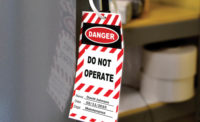OSHA The control of hazardous energy (lockout/tagout) 1910.147

History
The Control of Hazardous Energy (Lockout/Tagout), 29 CFR 1910.147, standard was promulgated on September 1, 1989, Federal Register, Volume 54, No. 169 (pages 36644-36690), and was effective January 2, 1990, as announced Federal Register, Volume 54, No. 213, November 6, 1989 (page 46610).
Why this standard is important
Employees servicing or maintaining machines or equipment may be exposed to serious physical harm or death if hazardous energy is not properly controlled. Craft workers, machine operators, and laborers are among the three million workers who service equipment and face the greatest risk. Compliance with the lockout/tagout standard prevents an estimated 120 fatalities and 50,000 injuries each year. Workers injured on the job from exposure to hazardous energy lose an average of 24 workdays for recuperation.
Hazards
Workers servicing or maintaining machines or equipment may be seriously injured or killed if hazardous energy is not properly controlled. Injuries resulting from the failure to control hazardous energy during maintenance activities can be serious or fatal. Injuries may include electrocution, burns, crushing, cutting, lacerating, amputating, or fracturing body parts, and others.
Enforcement Statistics
October 2015 through September 2016 – totals for all industries
Citations: 2,898
Inspections: 1,627
Penalty: $12,996,613
#5 on OSHA’s Top 10 Most Frequently Cited Standards
Most Frequently Cited Provisions
- The employer shall establish a program consisting of energy control procedures, employee training and periodic inspection.
- Procedures shall be developed, documented and utilized for the control of potentially hazardous energy.
- Locks, tags, chains, wedges, key blocks, adapter pins, self-locking fasteners, or other hardware shall be provided...for isolating, securing or blocking of machines or equipment.
- The employer shall conduct a periodic inspection of the energy control procedure at least annually.
- The employer shall provide training to ensure that the purpose and function of the energy control program are understood by employees and that the knowledge and skills required...are acquired by employees.
Most cited industries
- Fabricated Metal Product Mfg
- Food Mfg
- Wood Product Mfg
- Transportation Equipment Mfg
- Plastics and Rubber Products Mfg
- Mechant Wholesalers, Durable Goods
- Machinery Mfg
- Primary Metal Mfg
- Paper Mfg
- Chemical Mfg
What must employers do to protect employees?
The standards establish requirements that employers must follow when employees are exposed to hazardous energy while servicing and maintaining equipment and machinery. Some of the most critical requirements from these standards are outlined below:
- Develop, implement, and enforce an energy control program.
- Use lockout devices for equipment that can be locked out. Tagout devices may be used in lieu of lockout devices only if the tagout program provides employee protection equivalent to that provided through a lockout program.
- Ensure that new or overhauled equipment is capable of being locked out.
- Develop, implement, and enforce an effective tagout program if machines or equipment are not capable of being locked out.
- Develop, document, implement, and enforce energy control procedures. [See the note to 29 CFR 1910.147(c)(4)(i) for an exception to the documentation requirements.]
- Use only lockout/tagout devices authorized for the particular equipment or machinery and ensure that they are durable, standardized, and substantial.
- Ensure that lockout/tagout devices identify the individual users.
- Establish a policy that permits only the employee who applied a lockout/tagout device to remove it. [See 29 CFR1910.147(e)(3) for exception.]
- Inspect energy control procedures at least annually.
- Provide effective training as mandated for all employees covered by the standard.
- Comply with the additional energy control provisions in OSHA standards when machines or equipment must be tested or repositioned, when outside contractors work at the site, in group lockout situations, and during shift or personnel changes
Lockout-Tagout Standard Compliance Directive
Directive number: CPL 02-00-147
Effective date: 2/11/08
Subject: The Control of Hazardous Energy – Enforcement Policy and Inspection Procedures
Lockout-Tagout Compliance Assistance
- OSHA’s Lockout/Tagout Fact Sheet describes the practices and procedures necessary to disable machinery or equipment to prevent the release of hazardous energy.
- Lockout-Tagout Interactive Training Program. OSHA eTool. Interactive tool to provide the user with an in-depth understanding of the LOTO standard, with three components: Tutorial, Hot Topics, and Case Studies.
- 1910.147 Appendix A – Typical Minimal Lockout Procedures
A simple lockout procedure is provided to assist employers in developing their procedures so they meet the requirements of this standard. When the energy isolating devices are not lockable, tagout may be used, provided the employer complies with the provisions of the standard which require additional training and more rigorous periodic inspections. When tagout is used and the energy isolating devices are lockable, the employer must provide full employee protection (see paragraph (c)(3)) and additional training and more rigorous periodic inspections are required. For more complex systems, more comprehensive procedures may need to be developed, documented, and utilized.
- Control of Hazardous Energy - Lockout/Tagout. OSHA Publication 3120, (Revised 2002). This booklet presents OSHA's general requirements for controlling hazardous energy during service or maintenance of machines or equipment. It is not intended to replace or to supplement OSHA standards regarding the control of hazardous energy.
- Control of Hazardous Energy Sources - Self-Inspection Checklist - Schools. U.S. Department of Health and Human Services (DHHS), National Institute for Occupational Safety and Health (NIOSH) Publication No. 2004-101, (October 2003). This self-inspection checklist covers regulations issued by OSHA as a general industry standard under 29 CFR 1910.147.
- Preventing Worker Deaths from Uncontrolled Release of Electrical, Mechanical, and Other Types of Hazardous Energy. U.S. Department of Health and Human Services (DHHS), National Institute for Occupational Safety and Health (NIOSH) Publication No. 99-110, (August 1999). NIOSH Alert that provides assistance in preventing the death or injury of workers exposed to the unexpected or uncontrolled release of hazardous energy.
- Guidelines for Controlling Hazardous Energy During Maintenance and Servicing [Lockout/Tagout]. U.S. Department of Health and Human Services (DHHS), National Institute for Occupational Safety and Health (NIOSH) Publication No. 83-125, (September 1983). NIOSH Guidelines that outline methods for protecting workers from injuries caused by the release of hazardous energy
- Sample Written Program for Control of Hazardous Energy (Lockout/Tagout). Texas Department of Insurance. Sample lockout/tagout program provided as a guide to assist employers and employees in complying with the requirements of 29 CFR 1910.147, as well as to provide other helpful information. It is not intended to supersede the requirements of the standard.
- Control of Hazardous Energy (Lockout/Tagout) — 29 CFR 1910.147 - Sample Program. Maine Department of Labor. Sample hazardous energy control program provided by SafetyWorks! as a guide to help employers implement OSHA's Control of Hazardous Energy (Lockout/Tagout) standard (29 CFR 1910.147) in their workplace.
Sponsor: www.accuform.com, 1-800-237-1001
Looking for a reprint of this article?
From high-res PDFs to custom plaques, order your copy today!






